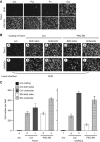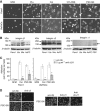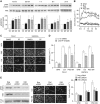Pancreatic stellate cells promote hapto-migration of cancer cells through collagen I-mediated signalling pathway
- PMID: 24201748
- PMCID: PMC3899756
- DOI: 10.1038/bjc.2013.706
Pancreatic stellate cells promote hapto-migration of cancer cells through collagen I-mediated signalling pathway
Abstract
Background: Pancreatic stellate cells (PSCs) promote metastasis as well as local growth of pancreatic cancer. However, the factors mediating the effect of PSCs on pancreatic cancer cells have not been clearly identified.
Methods: We used a modified Boyden chamber assay as an in vitro model to investigate the role of PSCs in migration of Panc1 and UlaPaCa cells and to identify the underlying mechanisms.
Results: PSC supernatant (PSC-SN) dose-dependently induced the trans-migration of Panc1 and UlaPaCa cells, mainly via haptokinesis and haptotaxis, respectively. In contrast to poly-L-lysine or fibronectin, collagen I resembled PSC-SN with respect to its effect on cancer cell behaviours, including polarised morphology, facilitated adhesion, accelerated motility and stimulated trans-migration. Blocking antibodies against integrin α2/β1 subunits significantly attenuated PSC-SN- or collagen I-promoted cell trans-migration and adhesion. Moreover, both PSC-SN and collagen I induced the formation of F-actin and focal adhesions in cells, which was consistent with the constantly enhanced phosphorylation of focal adhesion kinase (FAK, Tyr397). Inhibition of FAK function by an inhibitor or small interference RNAs significantly diminished the effect of PSC-SN or collagen I on haptotaxis/haptokinesis of pancreatic cancer cells.
Conclusion: Collagen I is the major mediator for PSC-SN-induced haptokinesis of Panc1 and haptotaxis of UlaPaCa by activating FAK signalling via binding to integrin α2β1.
Figures







Similar articles
-
Paracrine IL-6 signaling mediates the effects of pancreatic stellate cells on epithelial-mesenchymal transition via Stat3/Nrf2 pathway in pancreatic cancer cells.Biochim Biophys Acta Gen Subj. 2017 Feb;1861(2):296-306. doi: 10.1016/j.bbagen.2016.10.006. Epub 2016 Oct 14. Biochim Biophys Acta Gen Subj. 2017. PMID: 27750041
-
Activation of focal adhesion kinase enhances the adhesion and invasion of pancreatic cancer cells via extracellular signal-regulated kinase-1/2 signaling pathway activation.Mol Cancer. 2005 Oct 6;4:37. doi: 10.1186/1476-4598-4-37. Mol Cancer. 2005. PMID: 16209712 Free PMC article.
-
Galectin-3 Mediates Tumor Cell-Stroma Interactions by Activating Pancreatic Stellate Cells to Produce Cytokines via Integrin Signaling.Gastroenterology. 2018 Apr;154(5):1524-1537.e6. doi: 10.1053/j.gastro.2017.12.014. Epub 2017 Dec 21. Gastroenterology. 2018. PMID: 29274868
-
Pancreatic cancer: the role of pancreatic stellate cells in tumor progression.Pancreatology. 2010;10(6):673-81. doi: 10.1159/000320711. Epub 2011 Jan 18. Pancreatology. 2010. PMID: 21242706 Review.
-
Heterogeneous Pancreatic Stellate Cells Are Powerful Contributors to the Malignant Progression of Pancreatic Cancer.Front Cell Dev Biol. 2021 Dec 20;9:783617. doi: 10.3389/fcell.2021.783617. eCollection 2021. Front Cell Dev Biol. 2021. PMID: 34988078 Free PMC article. Review.
Cited by
-
The cross-talk between the macro and micro-environment in precursor lesions of pancreatic cancer leads to new and promising circulating biomarkers.J Exp Clin Cancer Res. 2024 Jul 18;43(1):198. doi: 10.1186/s13046-024-03117-5. J Exp Clin Cancer Res. 2024. PMID: 39020414 Free PMC article. Review.
-
Endogenously Expressed IL-4Rα Promotes the Malignant Phenotype of Human Pancreatic Cancer In Vitro and In Vivo.Int J Mol Sci. 2017 Mar 28;18(4):716. doi: 10.3390/ijms18040716. Int J Mol Sci. 2017. PMID: 28350325 Free PMC article.
-
The prognostic value and pathobiological significance of Glasgow microenvironment score in gastric cancer.J Cancer Res Clin Oncol. 2017 May;143(5):883-894. doi: 10.1007/s00432-017-2346-1. Epub 2017 Feb 8. J Cancer Res Clin Oncol. 2017. PMID: 28180998 Free PMC article.
-
Stellate Cells Aid Growth-Permissive Metabolic Reprogramming and Promote Gemcitabine Chemoresistance in Pancreatic Cancer.Cancers (Basel). 2021 Feb 3;13(4):601. doi: 10.3390/cancers13040601. Cancers (Basel). 2021. PMID: 33546284 Free PMC article. Review.
-
Optimizing stem cell functions and antibacterial properties of TiO2 nanotubes incorporated with ZnO nanoparticles: experiments and modeling.Int J Nanomedicine. 2015 Mar 12;10:1997-2019. doi: 10.2147/IJN.S74418. eCollection 2015. Int J Nanomedicine. 2015. Retraction in: Int J Nanomedicine. 2022 Jan 28;17:463-464. doi: 10.2147/IJN.S359722. PMID: 25792833 Free PMC article. Retracted.
References
-
- Apte MV, Park S, Phillips PA, Santucci N, Goldstein D, Kumar RK, Ramm GA, Buchler M, Friess H, McCarroll JA, Keogh G, Merrett N, Pirola R, Wilson JS. Desmoplastic reaction in pancreatic cancer: role of pancreatic stellate cells. Pancreas. 2004;29:179–187. - PubMed
-
- Arao S, Masumoto A, Otsuki M. Beta1 integrins play an essential role in adhesion and invasion of pancreatic carcinoma cells. Pancreas. 2000;20:129–137. - PubMed
Publication types
MeSH terms
Substances
LinkOut - more resources
Full Text Sources
Other Literature Sources
Medical
Molecular Biology Databases
Miscellaneous

